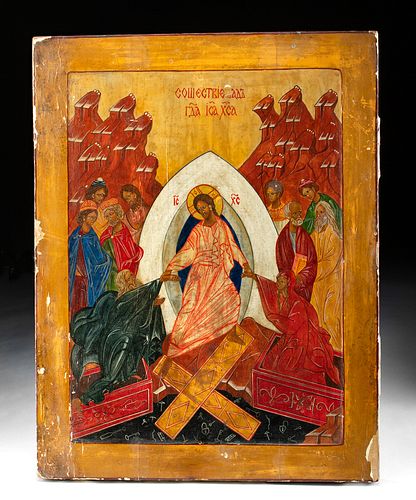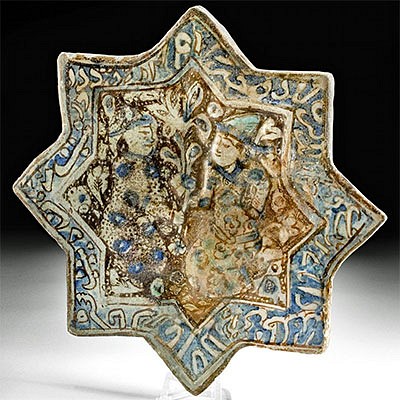19th C. Russian Icon - Harrowing of Hell
Lot 341
About Seller
Artemis Fine Arts
686 S Taylor Ave, Ste 106
Louisville, CO 80027
United States
Selling antiquities, ancient and ethnographic art online since 1993, Artemis Gallery specializes in Classical Antiquities (Egyptian, Greek, Roman, Near Eastern), Asian, Pre-Columbian, African / Tribal / Oceanographic art. Our extensive inventory includes pottery, stone, metal, wood, glass and textil...Read more
Estimate:
$2,000 - $3,000
Absentee vs Live bid
Two ways to bid:
- Leave a max absentee bid and the platform will bid on your behalf up to your maximum bid during the live auction.
- Bid live during the auction and your bids will be submitted real-time to the auctioneer.
Bid Increments
| Price | Bid Increment |
|---|---|
| $0 | $25 |
| $300 | $50 |
| $1,000 | $100 |
| $2,000 | $250 |
| $5,000 | $500 |
| $10,000 | $1,000 |
| $20,000 | $2,500 |
| $50,000 | $5,000 |
| $100,000 | $10,000 |
| $200,000 | $20,000 |
About Auction
By Artemis Fine Arts
May 20, 2021
Set Reminder
2021-05-20 10:00:00
2021-05-20 10:00:00
America/New_York
Bidsquare
Bidsquare : Ancient & Ethnographic From Around The World
https://www.bidsquare.com/auctions/artemis-gallery/ancient-ethnographic-from-around-the-world-6979
Ancient art from Egypt, Greece, Italy and the Near East, as well as Asian, Fossils, Pre-Columbian, Native American, African / Tribal / Oceanic, Fine art, and much more! All categories, all price ranges... all legally acquired and guaranteed to be as described or your money back. Artemis Fine Arts info@artemisgallery.com
Ancient art from Egypt, Greece, Italy and the Near East, as well as Asian, Fossils, Pre-Columbian, Native American, African / Tribal / Oceanic, Fine art, and much more! All categories, all price ranges... all legally acquired and guaranteed to be as described or your money back. Artemis Fine Arts info@artemisgallery.com
- Lot Description
Eastern Europe, Russia, ca. 19th century CE. Beautifully delineated in egg tempera and gold leaf on gesso on wood, an icon depicting the Harrowing of Hell, Christ's triumphant descent into Hell between the Crucifixion and Resurrection, when he brought salvation to all of the righteous dead. In this depiction, Christ stands in the center, wearing long white robes outlined in red with a gilt halo framing his visage, as he wrests the primogenitors, Adam and Eve, up from the doors of Hell which he has ripped from their hinges. Surrounding them are the souls of the righteous. The four-letter Christogram IC XC - a traditional Greek abbreviation used in Eastern Christianity flanks Christ, and there is a Greek inscription above the scene. Gilding: 41% gold. Size: 14.625" L x 11.3" W (37.1 cm x 28.7 cm)
Rather than presenting Christ emerging from his sepulcher, He is depicted as already resurrected and breaking down he doors of hell. "His flesh was as hair thrown into the arms of death, so that the dragon of hell, hoping to devour it, would instead vomit up those he had already devoured." (John of Damascus)
Icons (icon means "image" in Greek) are sacred objects within the Eastern Orthodox Christian tradition. Found in homes as well as churches, these painted images depict holy persons and saints as well as illustrate scenes from the Scriptures. Icons are not worshiped, but are instead venerated for their ability to focus the power of an individual's prayer to God. As a focus for prayers and meditation for believers, icons serve as "windows into heaven."
Provenance: private New Jersey, USA collection
All items legal to buy/sell under U.S. Statute covering cultural patrimony Code 2600, CHAPTER 14, and are guaranteed to be as described or your money back.
A Certificate of Authenticity will accompany all winning bids.
We ship worldwide and handle all shipping in-house for your convenience.
#161916Expected age cracks and surface wear with scuffs, nicks, and some loss to pigmentation as shown. Back slats are present on the verso.Condition
- Shipping Info
-
All shipping is handled in-house for your convenience. Your invoice from Artemis Gallery will include shipping calculation instructions. If in doubt, please inquire BEFORE bidding for estimated shipping costs for individual items.
-
- Buyer's Premium



 EUR
EUR CAD
CAD AUD
AUD GBP
GBP MXN
MXN HKD
HKD CNY
CNY MYR
MYR SEK
SEK SGD
SGD CHF
CHF THB
THB















